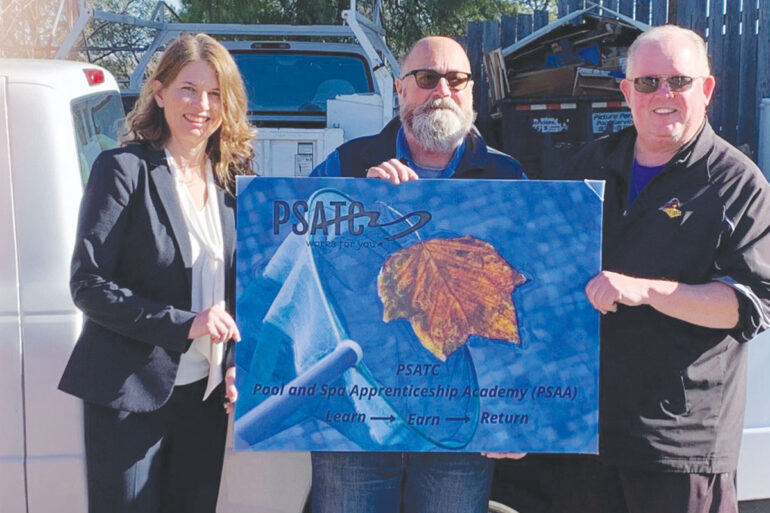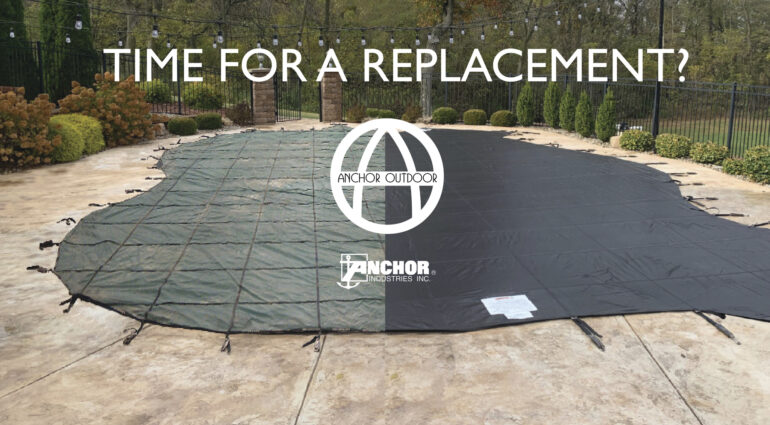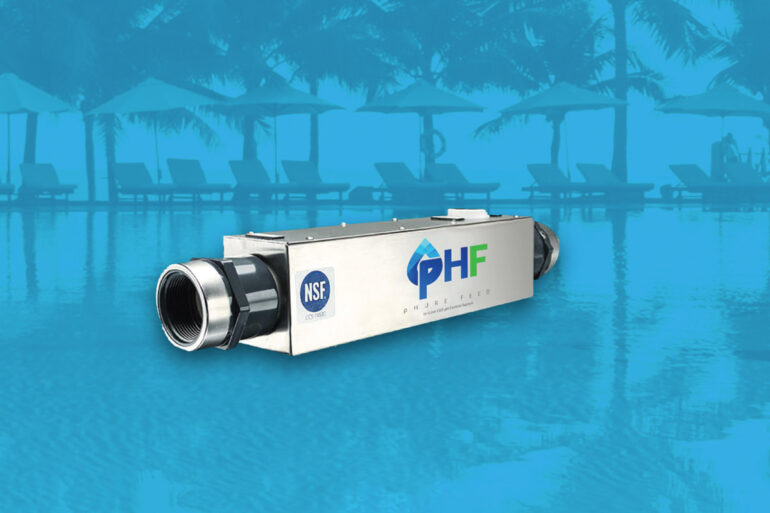The NPC Start-up Procedure

With another pool season almost upon us, thoughts are turning to soaking up the sun and enjoying a dip in a cool pool. Whether new construction or a remodel, all pools need a start-up procedure to maintain longevity and aesthetics.
The importance of a good start-up procedure cannot be overstated. It provides balanced water to protect the finish and equipment and sanitizes water for the protection of swimmers. There are many types of cementitious finishes available today, and some may have specific needs that are addressed in the different procedures designed for these finishes. The NPC Start-up Procedure is a traditional start-up for standard plaster that has been used in the swimming pool industry for more than 33 years.
A new finish is soft and susceptible to discolorations and scaling during the first weeks after installation. Because of this initial soft condition, it is advisable to use nylon bristle brushes or a nylon brush-vac head to remove plaster dust and clean the surface. With time, the new finish will become harder, more durable and more stain-resistant.
This increase in the hardness of the surface is due to a process called hydration, which occurs when cement and water are mixed to create a plaster finish. This process will continue long past the time of mixing, placement and filling of the swimming pool. Thirty days past the initial fill, the hydration of the new finish is only 60-70% complete. The ongoing process of hydration helps to harden and increase the durability of the new finish.
During the hydration process, a secondary reaction occurs, creating calcium hydroxide or plaster dust, which makes up 20-25% of the matrix — which includes the cement and aggregate of the mix — and is the softest, most soluble part of the matrix (refer to NPC Technical Bulletin #3 for further information.) The importance of calcium hydroxide is twofold — first, the plaster dust must be removed as quickly as possible to avoid scaling and discoloration, and second, the production of calcium hydroxide constantly changes the water chemistry, which requires monitoring and management.
The first step is to test the source water before day one of the start-up, so you arrive prepared. While you are checking and testing the fill water, inspect the circulation and filtration equipment to ensure it is operational before the plaster is installed.
Pool Fill Day
Filling the pool seems simple enough, but improper fill practices can lead to problems. If a garden hose is being used to fill the pool, cover the metal end of the hose with a clean, soft cloth to prevent scarring. This cloth will also prevent erosion of the surface from the water pressure. The hose must be placed in the deepest part of the pool and filled uninterrupted until reaching midway on the waterline. Fill the pool as quickly as possible to help minimize shrinkage cracks.
If a water truck or fire hydrant is being used to fill larger pools, a 24-inch cushion of water is to be placed in the deep end of the pool, followed by water from the truck or hydrant cascading into the accumulated water cushion. Remember to test the water being supplied by the truck or hydrant. Fire hydrants are known to be sources of high metal content and should be dealt with by using a good metal sequestrant.
If multiple hoses are used in the filling process, remember to always fill from the bottom up. Do not allow water to run down the floor or walls. This will create hydration issues that look like streaks going down the walls or floor. At no time during the fill should any person or pet be allowed in the pool until the water is balanced and sanitized.
Once the pool is full, turn on the circulation and filtration system. Continuous operation of the system should be a minimum of 72 hours, and the longer the better. Remember — the new finish is soft and susceptible to staining at this early stage. Better water clarity will dramatically improve the results of your start-up. Do not turn on the heater until all the plaster dust is gone, as per the manufacturer’s recommendations.
Adding Chemicals
Safety is always a concern when handling chemicals used in water chemistry management — the safety of the person handling the chemicals and the safety of the new finish and surrounding deck and equipment. Always pre-dilute chemicals before adding them to the pool water, and always add chemicals to water, never water to chemicals. Keep safety in mind, and use the appropriate safety equipment when adding chemicals to a 5-gallon bucket of water for better distribution purposes. Brush down the pool after chemicals are added to help with distribution.
POOL START-UP PROCEDURE DAY 1
Test fill water for pH, total alkalinity and calcium hardness. Record all test results.
High alkalinity should be adjusted downward to 80-100 ppm using pre-diluted muriatic acid (31-33% hydrochloric acid). Always pre-dilute the acid by adding it to a 5-gallon bucket of water.
Low alkalinity should be adjusted upward to 80 ppm using sodium bicarbonate.
After the alkalinity is in the 80-100 ppm range, the pH should be reduced to 7.2-7.6, adding pre-diluted muriatic acid.
Low calcium hardness should be adjusted upward to 80-100 ppm. Adjustments of hardness increaser (calcium chloride) should be dissolved and added in 10-pound increments, with each dosage separated by several hours. Never add hardness increaser (calcium chloride) and alkalinity increaser (sodium bicarbonate) at the same time; these two chemicals are incompatible, and adding them together may cause a reaction creating calcium carbonate. This will make the water cloudy and increase scaling on the new pool finish and the pool equipment.
Brush the entire pool surface thoroughly at least twice a day to remove all plaster dust. Wheeled vacuums or wheeled pool cleaners should not be used in the pool until after 28 days, but brush vacuums or nonwheeled pool cleaners are allowed.
Although optional, it is recommended to add a sequestering agent, following the manufacturer’s recommended initial start-up dosage and, when used, to continue dosing at the recommended maintenance dosage thereafter.
Continuous operation of the pumps and filtration system is mandatory for seven days or until the plaster dust has been brushed away and filtered out and the water is no longer cloudy, a minimum of 72 hours.
Do not add chlorine to the pool water for 48 hours; do not turn on the pool heater until there is no plaster dust in the pool.
DAY 2
Again, test the pool water for pH, total alkalinity and calcium hardness, and repeat the steps of day one, except for step seven.
Once the total alkalinity is adjusted to 80-100 ppm and the pH is adjusted to 7.2-7.6, then adjust calcium hardness upward to 100-150 ppm. Adjustments of hardness increaser (calcium chloride) should be dissolved and added in 10-pound increments, with each dosage separated by several hours.
DAY 3
Test and adjust the pH, total alkalinity and calcium hardness as per day two, step two.
Repeat steps six and eight from day one.
Add pre-diluted chlorine or liquid chlorine to a 1.5-3.0 ppm level. For saltwater pools, do not add salt within at least the first 30 days.
Brush the entire pool surface thoroughly at least twice daily to remove all plaster dust.
DAYS 4-7
Test and adjust the pH and total alkalinity, maintaining ranges of day two.
Repeat steps six and eight of day one each day for seven days to help prevent surface scaling.
In-floor and directional eyeballs may be added once water chemistry is balanced.
DAY 4
Calcium hardness should be increased slowly, if necessary, to a minimum of 200 ppm.
Begin adjusting the cyanuric acid to 30-50 ppm. Add CYA through the skimmer while the pumps and filtration system are running for a minimum of three days. After each addition, brush the entire finish surface. Concentrated CYA can cause pigmented finishes to discolor.
DAY 7
If there is any plaster dust remaining, remove it with a pool brush vacuum.
DAYS 7-28
Complete this step to ensure the pool is clean:
Once plaster dust is removed, and with a good pool cleaning system in place, brushing can be limited to the removal of visually observed material (i.e., leaves, dirt, etc.) or when adding chemicals.
After day 28, it is critical to continue ongoing maintenance of the finish and balanced water chemistry throughout the year. Continue brushing the pool finish once a week, adjusting the water chemistry as needed and cleaning the pool filter regularly. Pool water chemistry is constantly changing and must be continually monitored and adjusted. Maintaining proper levels of pH and carbonate alkalinity is vital to the longevity of the finish. The Langelier Saturation Index can be used to help keep water balanced.
Langelier Saturation Index
The Langelier Saturation Index is used to determine the status of pool water. It will determine if the water is in a positive, a negative or a balanced index.
A positive index will have scaling tendencies, which can lead to mineral or metal staining or discoloration of the finish. A negative index will have aggressive or corrosive tendencies and can lead to leaching, etching and discoloration of the finish. The NPC recommends maintaining the Langelier Saturation Index between 0.0 and +0.3 to prevent damage to the finish in a swimming pool. This is especially true in the first 6 months after a start-up.
For accuracy, the index uses carbonate alkalinity and not total alkalinity. Cyanuric acid is used in swimming pool water to protect free chlorine from destruction by the ultraviolet rays of the sun and is commonly referred to as a conditioner or stabilizer. When present in pool water, it must be accounted for because of its effect on the alkalinity of the pool water.
Total alkalinity doesn’t consider the presence of CYA in the water and is therefore inaccurate. Carbonate alkalinity does account for CYA in pool water and is used in the index for accuracy. To determine carbonate alkalinity, the equation is as follows: total alkalinity -30% of cyanuric acid concentration = carbonate alkalinity. Carbonate alkalinity is often overlooked in water chemistry management for one main reason — lack of awareness. On start-ups, total alkalinity is fine until you add CYA. Once the CYA is in the water, you must use the carbonate alkalinity calculation for accuracy in your water chemistry management.
The NPC Start-Up Procedure emphasizes the methods and timetables for the removal of the plaster dust that is created from the hydration process when cement and water are mixed. This procedure has been time-tested over thousands of pools. Do not be fooled by shortcuts like the “hot start” method. This procedure uses large amounts of muriatic acid to drive down the pH and alkalinity to extremely dangerous levels. The damage to new finishes is extensive and usually unrepairable. The NPC does not endorse this practice.
Improper start-ups can result in a variety of damaging and unsightly conditions in a swimming pool, including scale build-up, etching deterioration, damaged grout, metal stains and finish discoloration or staining.
If staining of the finish does occur, the first step is to identify what type of stain it is and what caused the stain. The quick response to drain and acid wash the pool is not always the right solution. Acid washes can be a useful tool when carried out correctly and conducted at the right time for the right reasons, but they don’t solve all issues, so it is imperative to determine the cause first.
The National Plasterers Council is here to help. We have an in-depth Start-Up Class, as well as detailed information in our Technical Manual, our Tech Bulletins and our website www.npconline.org.






